Californians need high-speed broadband—it is an essential conduit for opportunity, shaping access to education, employment, health services, and other spheres of life. Internet speed matters. More than half of all Internet traffic is now data-rich video, requiring higher capacity networks. All-fiber networks capable of delivering gigabit speeds have become the global standard for Internet connectivity.
In a first-ever analysis, "AT&T's Digital Divide in California" looks at the deployment of fiber-to-the-home (FTTH) service in California by the largest telecom company in the state. The findings show that the early deployment of the company’s “gigapower” all-fiber service is concentrated in wealthier communities, relegating lower-income neighborhoods to less advanced technologies that offer markedly slower speeds. Drawing on newly-released FCC data, the report highlights income-based disparities in service across 71 percent of California, or 56 California counties in which AT&T provides wireline phone and internet service. The report also reveals 42.8 percent of California households – approximately 4.1 million homes – in AT&T’s network do not have access to high-speed broadband from AT&T as defined by the Federal Communications Commission, which classifies this service as a 25 Megabits per second (Mbps) download/3 Mbps upload connection.
Download AT&T's Digital Divide in California.
Executive Summary
Californians need high-speed broadband—it is an essential conduit for opportunity, shaping access to education, employment, health services, and other spheres of life. Internet speed matters. More than half of all Internet traffic is now data-rich video, requiring higher capacity networks. All-fiber networks capable of delivering gigabit speeds have become the global standard for Internet connectivity.
With great fanfare, AT&T launched an initiative to build “GigaPower,” fiber-to-the-home networks to 12.5 million customer locations across its 21-state wireline footprint. This report provides the first analysis of the income distribution of AT&T’s initial fiber-to-thehome deployment in California. The analysis uses the most recent data (which presents data as of June 30, 2016) from the Federal Communications Commission (FCC) and correlates the FCC data with statistics on household income from the Census Bureau’s American Community Survey
The report also examines more generally AT&T’s advertised wireline broadband services in California. The analysis covers households located within AT&T’s California wireline footprint (i.e. households where AT&T California is an incumbent local exchange carrier). AT&T is the largest telecommunications carrier in California, with a landline network serving 70.8 percent of California households across 56 counties. AT&T is the largest telecommunications company in the United States, with revenue of $163.8 billion and profits of $13 billion in 2016.
The data reveals disturbing trends that will exacerbate the digital divide in California. First, AT&T’s initial fiberto-the-home deployment is disproportionately focused on high-income communities. Second, AT&T has left too many Californians stuck in the slow lane on the information highway, unable to participate fully in the expanding digital economy. Despite its large size and profitability, AT&T has fallen short of providing equitable access to high-speed broadband in California. The major findings from the June 2016 data are as follows:
AT&T’s Initial Fiber-to-the-Home Network Deployment is Concentrated in High-Income Communities
- The median household income of California communities with access to AT&T’s fiber-to-the-home (FTTH) network is $94,208. This exceeds by $32,297 the $61,911 median household income for all California households in the AT&T wireline footprint.
- In contrast, the median household income of California communities for whom the most advanced broadband technology available from AT&T is its slower U-verse fiber-to-the-neighborhood (FTTN) network is $67,021, which is $27,187 (28.9 percent) lower than the median household income of fiber-to-the-home households.
- Approximately one-quarter (27.6 percent) of households— about 2.7 million households—in AT&T’s California footprint are stuck with slow DSL. The median household income for California households for whom DSL is the most advanced broadband technology available from AT&T is $53,186, which is $41,022 (43.5 percent) lower than the median household income of fiber-to-thehome households.
Millions of Californians are Underserved by AT&T Broadband
- 1.7 million households are underserved by AT&T. The California Public Utilities Commission (CPUC) defines communities without access to broadband at a speed of at least 6 Megabits per second (Mbps) download/1.5 Mbps upload as underserved. A full 18.1 percent of California households in AT&T’s wireline footprint—approximately 1.7 million households—lack access to AT&T broadband according to this definition.
- 4.1 million households are without access to AT&T high-speed broadband. The Federal Communications Commission (FCC) defines highspeed broadband as digital transmission at 25/3 Mbps download/upload. Based on this definition, 42.8 percent of California households in AT&T’s wireline footprint, or approximately 4.1 million households,do not have access to AT&T broadband that meets the FCC’s high-speed definition of 25/3 Mbps.
- Rural California is left behind by AT&T. In 14 largely rural counties, virtually no household has access to AT&T broadband at the FCC’s 25/3 Mbps speed and one-third or more households are underserved without access to AT&T broadband at 6/1.5 Mbps.
- Many urban and suburban Californians are stuck in AT&T’s slow lane. AT&T’s slow speeds are not limited to rural areas. In Los Angeles county, for example, approximately 443,000 households (20.4 percent) in AT&T’s wireline footprint lack access to AT&T broadband at 6/1 Mbps and approximately 1.1 million households (51.5 percent) lack access to AT&T broadband at 25/3 Mbps. In Santa Clara County, the heart of Silicon Valley, approximately 98,000 households (17.5 percent) are underserved by AT&T and approximately 176,000 lack access to AT&T broadband at 25/3 Mbps.
Recommendations
Access to high-speed broadband is not a luxury, it is a necessity. Yet too many Californians are trapped on the wrong side of the digital divide. To remain a leader in high-tech innovation, California must do better. Public oversight and intervention is needed to ensure universal and affordable access to high-speed communications services. Policymakers must hold network carriers accountable to meet deployment benchmarks to ensure that essential services like high-speed broadband are provided in an affordable and equitable way.
Therefore, our recommendations are:
- Policymakers and community leaders should call on AT&T to accelerate investment in its wireline broadband network in California, expanding deployment of its all-fiber network to more communities on an equitable basis, and ensuring that everyone in its wireline footprint has access to a high-speed broadband connection.
- Policymakers and community leaders should call on AT&T to make available to the public its fiber deployment plans: where it plans to deploy fiber, the timeline for the deployment, the number of households that will be served by fiber, internal measures to ensure equitable access to diverse, low-income communities, and network investment plans in rural and other areas.
- The California legislature should reassert public authority over broadband network deployment by repealing SB1161, which places some limits on such public oversight, and should adopt legislation that establishes enforceable fiber deployment benchmarks that apply to all providers.
- The California Public Utilities Commission should convene public hearings in 2017 across the state on the availability of high-speed broadband in order to inform its 2018 report on the state of broadband in California. It should also continue to require broadband carriers to provide accurate information on broadband deployment by speed, technology, and customer types at a granular Census Block level and audit such data for accuracy; Lastly, it should publish and make available to the public statutorilymandated reports in a timely manner.
Introduction
cali for n ia i s a lead e r in digital innovation and technology, yet too many California residents are stuck in the slow lane on the information highway, with few competitive options for high-speed broadband. In this report, we focus on broadband availability from AT&T California because it is the largest legacy telephone company in the state, reaching 70.8 percent of California households—approximately 9.7 million households—across its wireline network in 56 counties. AT&T is also the largest telecommunications company in the nation, with revenue of $163.8 billion and profits of $13 billion in 2016.1
How AT&T invests in upgrading its wireline network to meet California consumers’ demand for high-capacity broadband will have far-reaching consequences for access to opportunity for individual Californians and the state as a whole. It will also have a significant impact on economic growth, job creation, and job quality. Network investment drives job growth at AT&T, which employs more than 17,000 union-represented technicians and customer service workers in California who earn family-supporting wages and benefits. Moreover, high-capacity broadband networks create a “virtuous cycle” of innovation leading to the development of new online applications and services, driving economic growth and job creation throughout the California economy. Academic studies have found that broadband expansion drives local economic growth and households that use the Internet have better employment outcomes than those who do not.2
The Digital Divide in California
Rural Broadband Gap: Only 43 percent of rural households have access to reliable broadband service.
Competition/Speed Gap: Only 36.2 percent of California households have more than one choice for a highspeed broadband provider (at 25/3 Mbps).
Adoption/Affordability Gap: Only 43 percent of low-income households subscribe to wireline broadband at home compared to 94 percent of high-income. Only 56 percent of Latinos, 68 percent of Asian Americans, and 66 percent of African Americans subscribe to wireline broadband at home compared to 83 percent of non-Hispanic whites.
Broadband Data Analysis
The AT&T Footprint
AT&T’s total California wireline broadband footprint encompasses 9,683,239 households, or 70.8 percent of total California households.3 The analysis in this report focuses on this footprint—the households located in areas where AT&T California is the Incumbent Local Exchange Carrier (ILEC). The data was compiled from two sources. The AT&T California broadband figures were compiled using the FCC Form 477 data. We used the most recent dataset, which presents data as of June 2016. The FCC Form 477 data is self-reported by each company and contains the maximum speed that companies advertise by census block.4 The income data was derived from the American Community Survey (ACS) five-year estimates, which provides demographic data at the block group level.5 The methodology is explained in more detail in the Appendix.
The FCC requires companies to report data separately for wireline, fixed wireless, and mobile broadband, as well as for residential consumer and business broadband availability. This study analyzes only wireline broadband advertised by AT&T to residential customers; all other broadband data is excluded. This methodology is consistent with the FCC 2016 Broadband Progress Report and the CPUC 2016 Competition Report, both of which explain that wireless is not a substitute for a home wireline connection because wireless is less reliable, more expensive, and it is difficult to do important activities such as homework or apply for a job on a smartphone or small mobile device.6
Because the FCC Form 477 data does not report the number of households with no broadband availability, this report focuses only on characteristics of California households with access to AT&T wireline broadband. However, the approximate number of California households in AT&T’s footprint with no broadband available from AT&T as of December 2015 was 252,075, comprising 2.5 percent of California households.7 This data is reported in Appendix Table 7.
This report analyzes AT&T residential wireline broadband deployment in California in two ways: technology and speed.
In AT&T service areas there are 252,075 households with no broadband available.
AT&T uses three wireline broadband technologies:
- DSL is the oldest and slowest wireline broadband technology. DSL delivers data traffic over the traditional copper network at download speeds typically in the range between 0.768 Mbps and 6 Mbps, depending on the customer’s distance from the switch. This is the only wireline broadband technology available to 2,677,141 California households (27.6 percent) in AT&T’s wireline footprint.
- VDSL, which AT&T markets as U-verse, is a fiberto-the-node (FTTN) network that delivers data over fiber to a neighborhood cabinet and then over the traditional copper network to the customer location. This technology typically delivers Internet download speeds between 12 and 18 Mbps over a single copper pair (again depending on the distance from the switch), but the speed can go up to 75 Mbps with pair bonding (two copper pairs) and boosts in digital frequency. AT&T U-verse deployment began in 2006 and continued through 2015. Almost threequarters (71.6 percent) of California households in the AT&T wireline footprint—6,937,319 households— have access to U-verse Internet, almost all in urban or suburban communities. AT&T has largely bypassed rural communities in deploying U-verse.
- Fiber-to-the-Home (FTTH). In the past year, AT&T began to deploy all-fiber networks in communities across its 21-state wireline footprint, including California. All-fiber networks are capable of delivering “Gigapower” speeds of up to 1,000 Mbps download and upload. To win regulatory approval of its DirecTV acquisition, AT&T committed to deploy all-fiber networks to 12.5 million customer locations by 2019. As of April 20, 2017 AT&T reported that it had deployed all-fiber networks to 4.6 million customer locations across its 21-state footprint.8
AT&T’s Initial Fiber-to-the-Home Deployment Targets High-Income Households
This analysis of the June 2016 FCC Form 477 data provides a first look at the income characteristics of the California communities that AT&T has chosen as pioneers in its fiber-to-the-home deployment. The June 2016 data reports AT&T fiber-to-the-home deployment in 2,886 census blocks reaching 68,029 households. Because there is no regulatory oversight of AT&T’s fiber-to-the-home deployment, AT&T is free to choose the communities in which it builds its all-fiber GigaPower network. Our analysis finds that AT&T has built its all-fiber network disproportionately in higher income communities. If this pattern continues, it has troubling consequences for low- and moderate-income Californians, leaving many without access to AT&T’s gold standard all-fiber network and exacerbating the digital divide.
Table 1 and Charts 1 through 8 detail the median household income for the most advanced technology available to households across California and in seven counties where AT&T has deployed fiber-to-the-home. A clear pattern emerges: those with access to AT&T’s fiber-to-the-home network have the highest median household income and those with only DSL availability have the lowest median income.
- The median household income of California communities with access to AT&T’s fiber-to-thehome (FTTH) network is $94,208, to U-verse is $67,021, and to the DSL network is $53,186.
- The median household income for fiber-to-thehome households exceeds those with only U-verse availability by $27,187 (28.9 percent) and those with only DSL availability by $41,022 (43.5 percent).
- This pattern is replicated in each of the seven counties where AT&T has early fiber deployment. For example, in Los Angeles County, the median income of households with fiber-to-the-home access is $110,474, compared with $60,534 for those with U-verse availability, and $47,894 for those with only DSL availability. This amounts to differences of $49,940 (45.2 percent) for U-verse and $62,580 (56.6 percent) for DSL.
- Our analysis did not find a correlation between the areas where AT&T has deployed its fiber-to-thehome technology and racial/ethnic characteristics, but policymakers should continue to monitor this aspect of AT&T’s fiber deployment going forward.
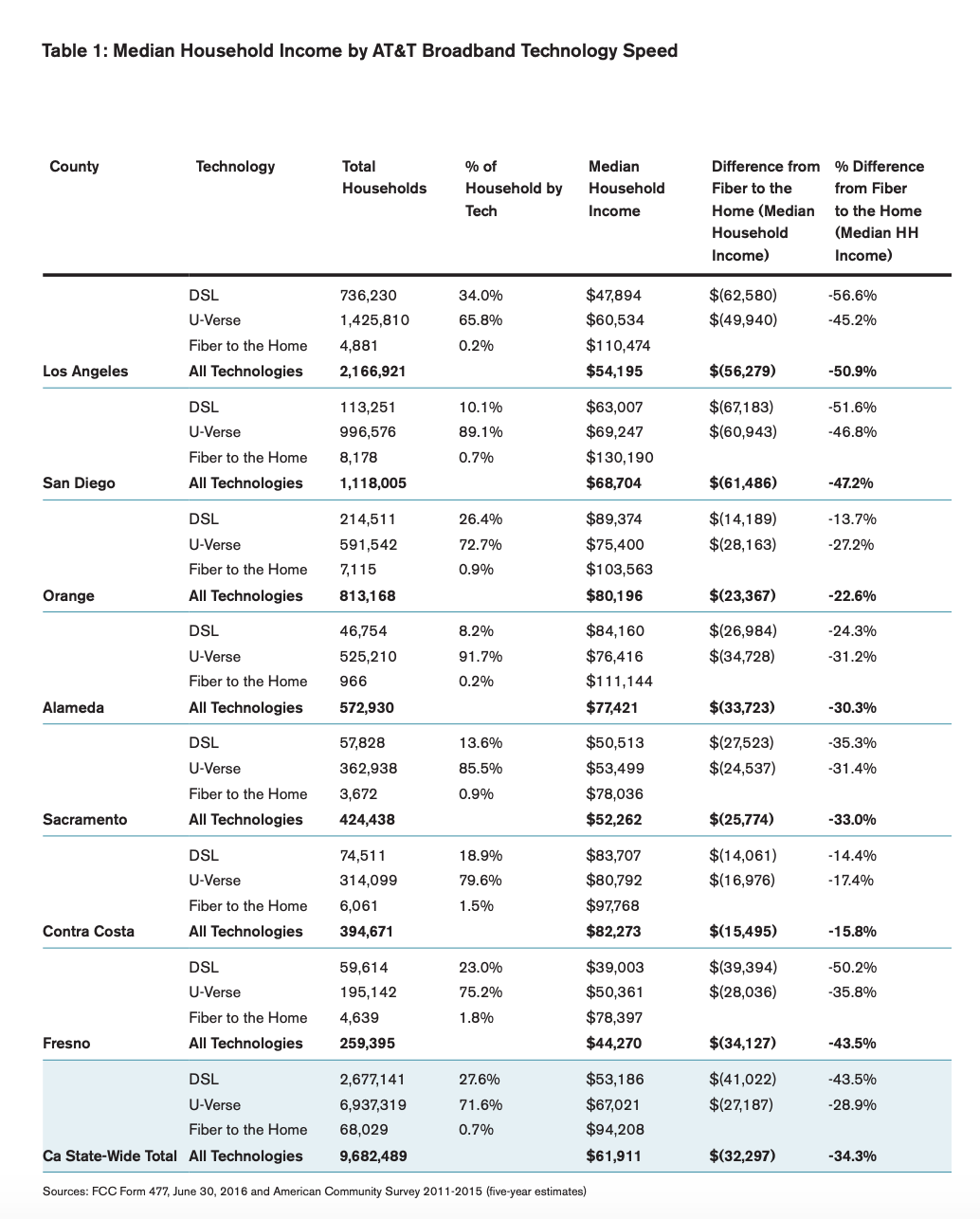
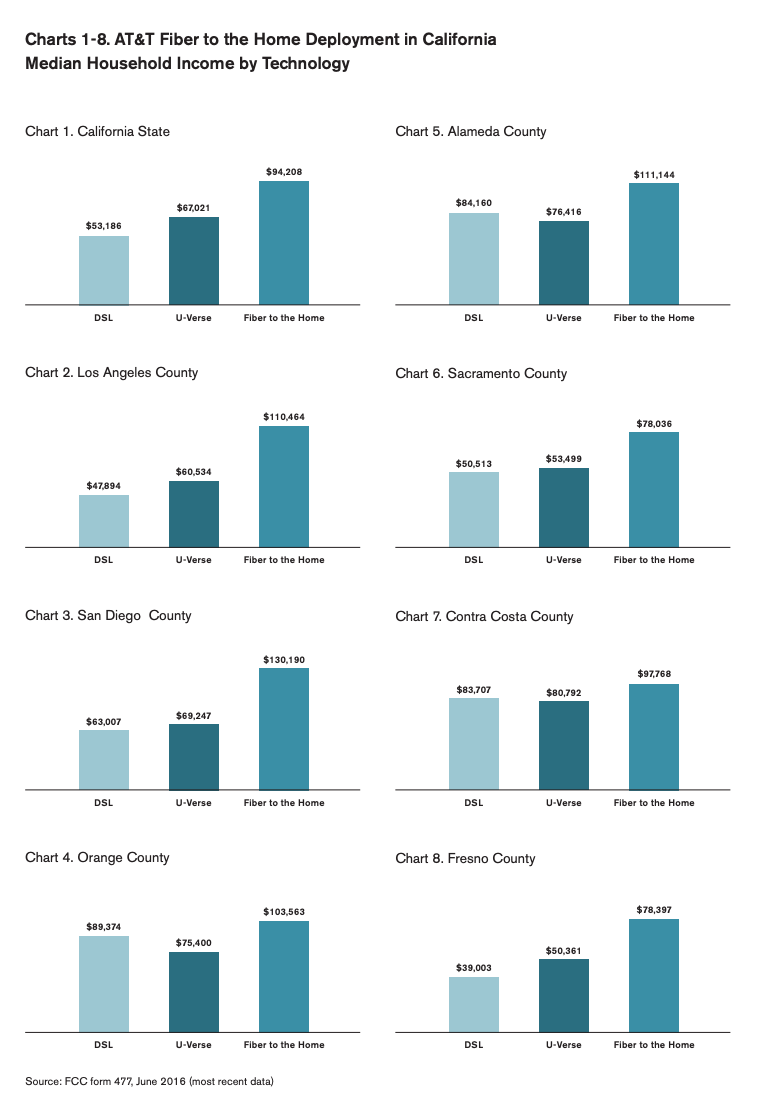
AT&T Leaves Many California Communities Stuck in the Slow Lane
AT&T’s advertised broadband speeds leave many Californians underserved, below the official CPUC standard pf 6/1 Mbps, and without high-speed broadband meeting the federal standard of 25/3 Mbps. The following figures drawn from our analysis present a stark picture of the inadequacy of AT&T’s wired broadband network in California. A complete list of AT&T broadband speeds by county is available in Table 5 in the Appendix.
- 18.1 percent of California households in AT&T’s wireline footprint, or approximately 1.7 million households, are underserved by AT&T broadband, without access to the CPUC benchmark of 6 Mbps broadband download.
- 42.8 percent of California households in AT&T’s wireline footprint—approximately 4.1 million households—cannot get AT&T broadband at the FCC broadband speed standard of 25/3 Mbps.
- AT&T does not advertise any broadband, at any speed, to more than one-quarter million (252,075) California households in its wireline footprint. (This figure is based on data from December 2015).9
- More than one-quarter (27.6 percent) of California households in AT&T’s wireline footprint— approximately 2.7 million households—can only get DSL from AT&T.
- AT&T’s higher-speed U-verse broadband technology is not available to virtually any household in 14 largely rural counties.
- Many urban and suburban counties have a significant number of households that are underserved by AT&T broadband. In Los Angeles County, approximately 443,000 households (20.4 percent) in AT&T’s wireline footprint lack access to AT&T broadband at 6/1 Mbps and approximately 1.1 million households (51.5 percent) lack access to AT&T broadband at 25/3 Mbps. In Santa Clara County, the heart of Silicon Valley, approximately 98,000 households (17.5 percent) are underserved by AT&T and approximately 176,000 lack access to AT&T broadband at 25/3 Mbps.
Table 5 in the Appendix breaks these statewide figures down by county. In 14 largely rural counties, virtually no household has access to AT&T broadband at the FCC’s 25/3 Mbps speed and between one-third and two-thirds or more households are underserved without access to AT&T broadband at the 6 Mbps download CPUC benchmark.
Table 6 in the Appendix provides a complete list of AT&T broadband technology deployment by county. In 14 largely rural counties—Amador, Butte, Calaveras, Glenn, Humboldt, Imperial, Tehama, Lake, Mendocino, Nevada, San Luis Obispo, Shasta, Siskiyou, and Tuolumne— AT&T has not deployed its more advanced U-verse fiberto-the-node (FTTN) or fiber-to-the-home technology to virtually any household.
AT&T’s lack of high-speed Internet is not limited to rural areas: the company also falls short in populous urban and suburban counties throughout California. Table 3 shows the number of households without access to AT&T broadband at CPUC and FCC standard speeds for the 10 counties where AT&T has the largest footprint.
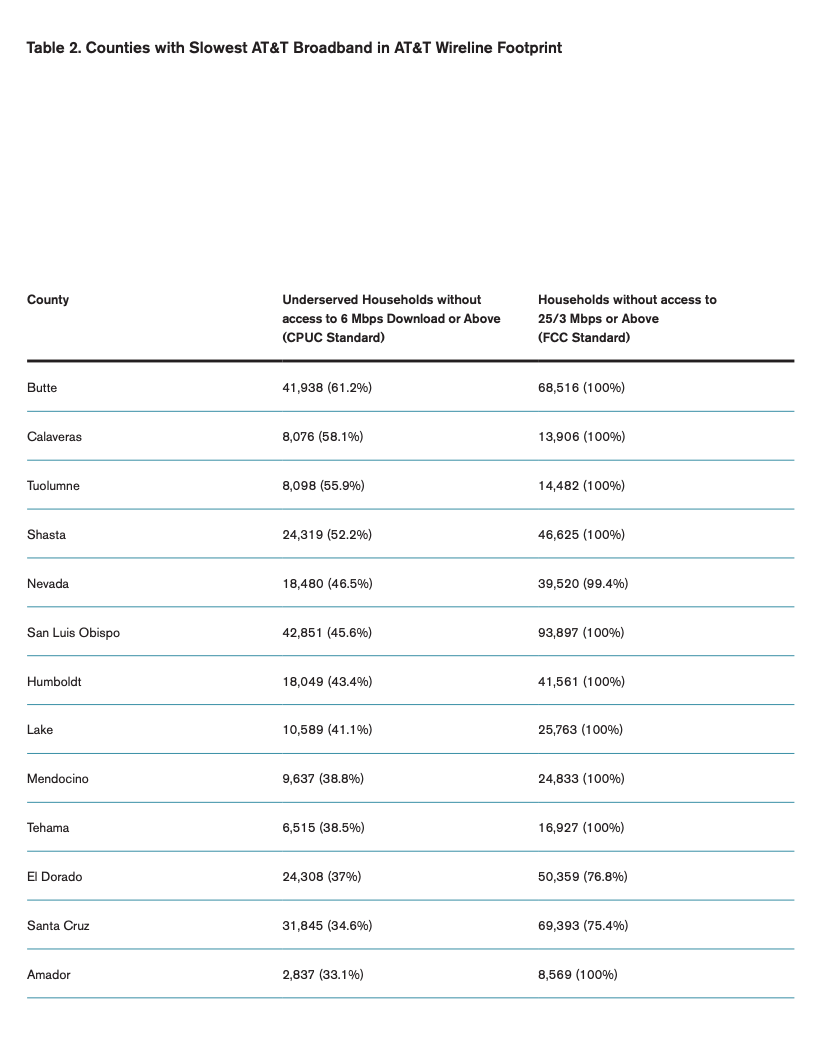
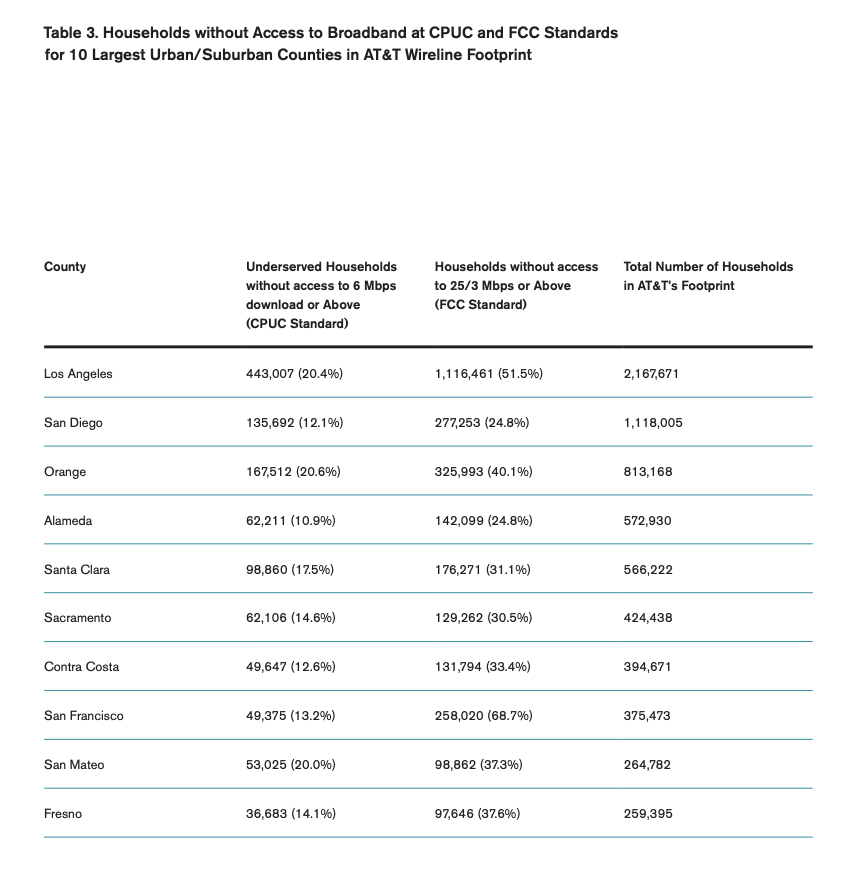
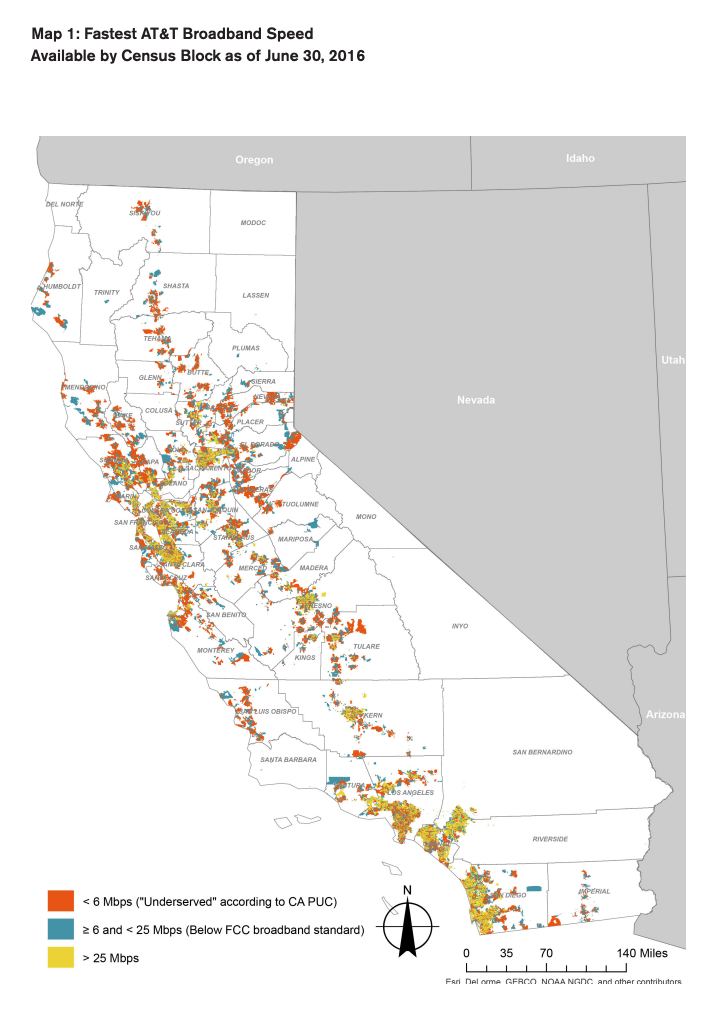
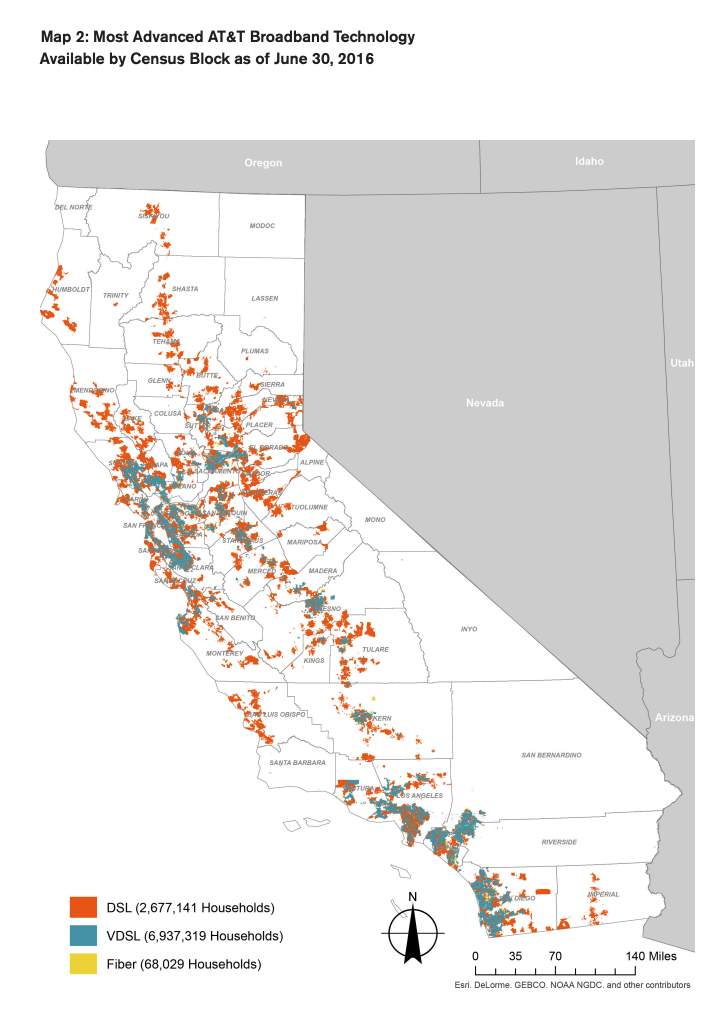
Policy Implications
This report provides a troubling view of AT&T’s wireline broadband deployment in California. It shows that AT&T’s initial fiber-to-the-home deployment reaches predominately higher-income communities, leaving lowand moderate-income Californians behind. It also shows that AT&T has left rural, and even many urban and suburban, Californians stuck in the slow lane.
In 2006, in response to a request from AT&T, the legislature established rules for statewide video franchising with passage of the Digital Infrastructure and Video Competition Act of 2006 (DIVCA, AB2897). The statute required AT&T to upgrade its network for video capability to at least 50 percent of California households, at least 30 percent of whom must be lowincome.10 As a result, AT&T was required to build its U-verse network to households at all income levels. However, as this report demonstrates, AT&T focused its Uverse investment in more densely-populated urban and suburban areas, leaving rural areas behind.
But today, as AT&T embarks on a new wave of wired infrastructure investment in California, the legislature has taken away substantial public oversight over its fiber deployment. In 2012, the legislature, with AT&T support, passed the “IP Deregulation Bill” (SB 1161) which prohibits regulatory authority over Voice-over-InternetProtocol (VoIP) and all IP-enabled broadband services. The bill sunsets in 2020. Until that date,or unless the statute is repealed,the legislature has effectively taken away CPUC authority to adopt policies to close the high-speed digital divide and to promote equitable fiber deployment in California.
This report demonstrates that deregulation is not working to drive AT&T investment to ensure that all California communities have access to the essential infrastructure of the 21st century – high-speed broadband. It is critical that policymakers take proactive steps to get AT&T to accelerate its wireline network investment and fiber deployment to bring high-speed broadband to all California communities.
Recommendations
Access to high-speed broadband is not a luxury, it is a necessity. Yet too many Californians are trapped on the wrong side of the digital divide. To remain a leader in high-tech innovation, California must do better. Public oversight and intervention is needed to ensure universal and affordable access to high-speed communications services. Policymakers must hold network carriers accountable to meet deployment benchmarks to ensure that essential services like high-speed broadband are provided in an affordable and equitable way.
Therefore, our recommendations are:
- Policymakers and community leaders should call on AT&T to accelerate investment in its wireline broadband network in California, expanding deployment of its all-fiber network to more communities on an equitable basis, and ensuring that everyone in its wireline footprint has access to a high-speed broadband connection.
- Policymakers and community leaders should call on AT&T to make available to the public its fiber deployment plans: where it plans to deploy fiber, the timeline for the deployment, the number of households that will be served by fiber, internal measures to ensure equitable access to diverse, low-income communities, and network investment plans in rural and other areas.
- The California legislature should reassert public authority over broadband network deployment by repealing SB1161, which places some limits on such public oversight, and should adopt legislation that establishes enforceable fiber deployment benchmarks that apply to all providers.
- The California Public Utilities Commission should convene public hearings in 2017 across the state on the availability of high-speed broadband in order to inform its 2018 report on the state of broadband in California. It should also continue to require broadband carriers to provide accurate information on broadband deployment by speed, technology, and customer types at a granular Census Block level and audit such data for accuracy; Lastly, it should publish and make available to the public statutorilymandated reports in a timely manner.
Appendix
Methodology
Data Sources The AT&T California broadband statistics referenced in this report were compiled using FCC Form 477 data available on the FCC website.11 We used the most recent publicly available dataset which presents data as of June 30, 2016. The FCC Form 477 data is selfreported by each company.
The FCC requires companies to report their data separately for wireline, fixed wireless and mobile broadband. The FCC also requires companies to report data separately for consumer and business broadband availability. Because this study analyzes fixed wireline broadband availability to residential customers, we eliminated from the data all places where AT&T does not provide residential (termed “consumer” in the FCC data) broadband.
The dataset contains the download and upload speeds advertised by each broadband company at the Census Block level. In an urban area, a Census Block is roughly equivalent to the size of a city block, while in rural areas Census Blocks can be larger due to low population density. The FCC notes that it is possible for broadband to be advertised to one household in a Census Block while not being available to another household in that same Block. However, for the purposes of this report, we assume that if a company advertises broadband with a particular speed and technology in a Census Block, every household in the Block has access to that speed and technology. This is a conservative assumption because it may overstate the true availability of broadband to all households in the Census Block. Because the Form 477 data concerns the speeds advertised by companies in various Census Block, this report does not examine consumer adoption of AT&T broadband in California, nor does this report examine whether the speeds advertised by AT&T are the actual speeds delivered by AT&T.
The FCC dataset contains information on four wireline broadband technologies offered by AT&T in California, summarized in the table below. This report classifies the technologies into three categories: DSL, U-verse, and fiber.
The FCC Form 477 data was cleaned and combined with other datasets to conduct the analysis in this report. The most important steps in this process were the following:
- We found AT&T’s fastest advertised download speed in each Census Block. AT&T reports maximum advertised speeds in 10 speed tiers: 0.768 Mbps, 1.5 Mbps, 3 Mbps, 6 Mbps, 12 Mbps, 18 Mbps, 24 Mbps, 45 Mbps, 75 Mbps, 1000 Mbps.
- We found AT&T’s most advanced technology available in each Census Block, with Fiber (Tech Code 50) being the most advanced and DSL (Tech Codes 10 and 11) being the least advanced.
- We merged the FCC data with 2010 Census data to determine the number of housing units (referred to as “households” in this report) by Census Block.13 Each Census Block is identified by a 12-digit FIPs Code. The third through fifth digit of this code identifies the county in which the Census Block is located. These digits were used to assign a county name to each Census Block.
- We merged the FCC data with American Community Survey (ACS) 5-Year Estimates of median household income from 2011-2015.14 The smallest geographical unit at which the ACS provides data on median household income is the Census Block Group, which typically has a population of 600 to 3,000 people. Each Census Block is located within a Census Block Group. We merged the FCC and ACS data by assigning to each Census Block the median household income of the Block Group containing that Block. Given the small number of households in each Block Group, we assume any variation in median household income across the Blocks located in a Block group would be minimal. Therefore, this procedure gives us reasonably accurate estimates of the median income of households with access to each AT&T broadband technology and speed.
- We identified in the December 2015 FCC data those Census Blocks where AT&T is an Incumbent Local Exchange Carrier but does not provide broadband. The Form 477 only requires reporting where a company provides broadband, but does not require reporting of “no broadband” Census Blocks. These Census Blocks were found through a threestage process. First, we mapped a Shapefile of the FCC’s March 2016 report of the all Incumbent Local Exchange Carrier (ILEC) study areas in the U.S. using ArcGIS, an industry-standard geographic information system software program.15 Second, we extracted AT&T California’s ILEC area and ran an intersect command in ArcGIS with a Shapefile of all California Census Blocks downloaded from the Census Bureau’s TIGER website. This intersect command allowed us to determine which Census Blocks are located in AT&T California’s ILEC areas. Third, we ran an erase command in ArcGIS to remove from the ILEC area all Census Blocks where AT&T advertises broadband, leaving just the Census Blocks where AT&T is an ILEC but provides no broadband.
Lastly, it is important to note that while some reports include upload speeds in their analysis, this report focuses on download speeds. Therefore, we assume that any household with download speeds of 25 Mbps or above will also have upload speeds of 3 Mbps or above.
Statewide Broadband Maps The maps in this report were created using ArcGIS, an industry-standard geographic information system software program. AT&T advertises 10 different broadband speeds in California (0.768, 1.5, 3, 6, 12, 18, 24, 45, 75, and 1000 Mbps). However, in order to increase the legibility of the county-level maps, these speeds were grouped into three colors corresponding to the following value ranges:
- Red: Less than 6 Mbps
- Blue: Greater than or equal to 6 Mbps and less than 25 Mbps
- Green: Greater than or equal to 25


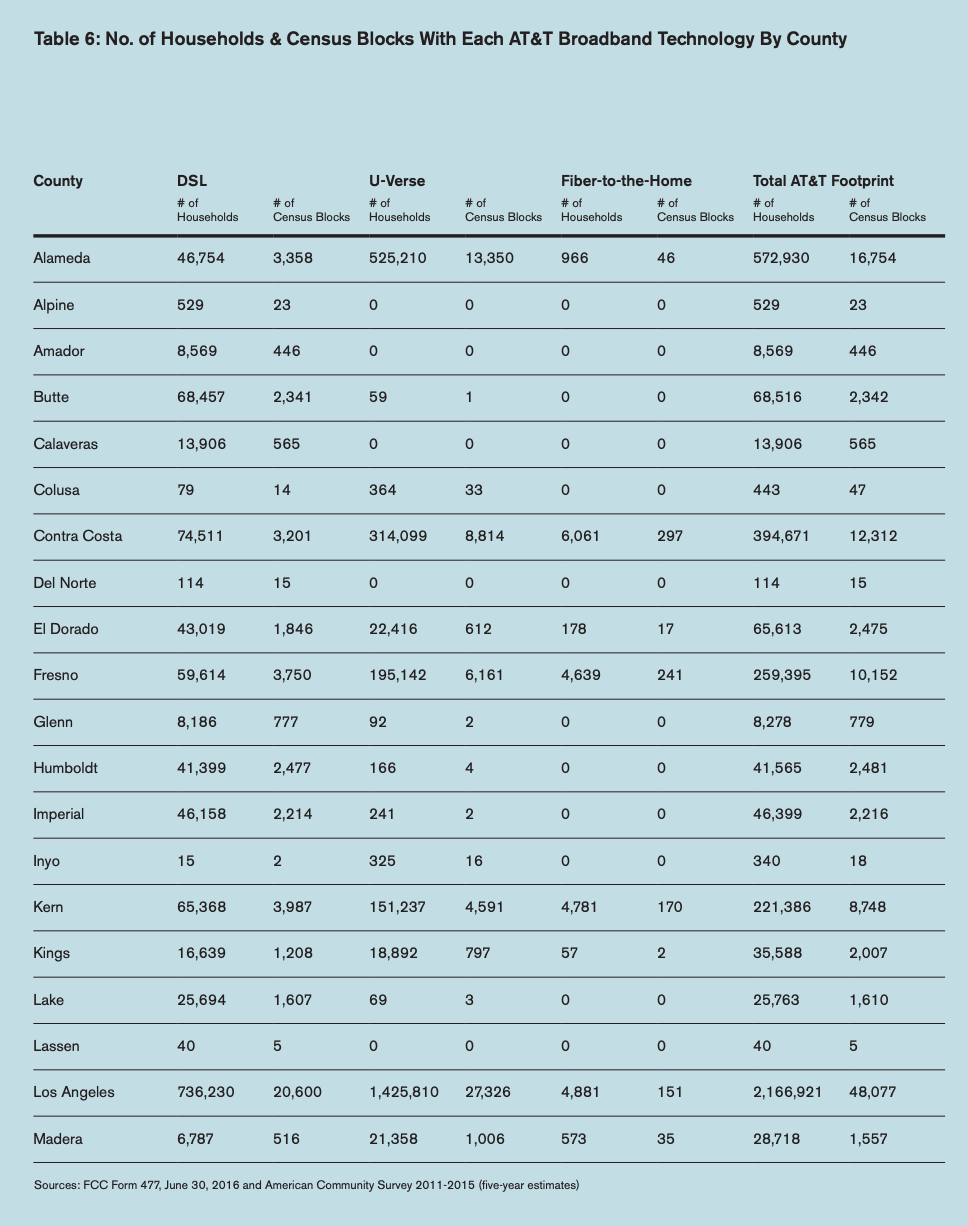
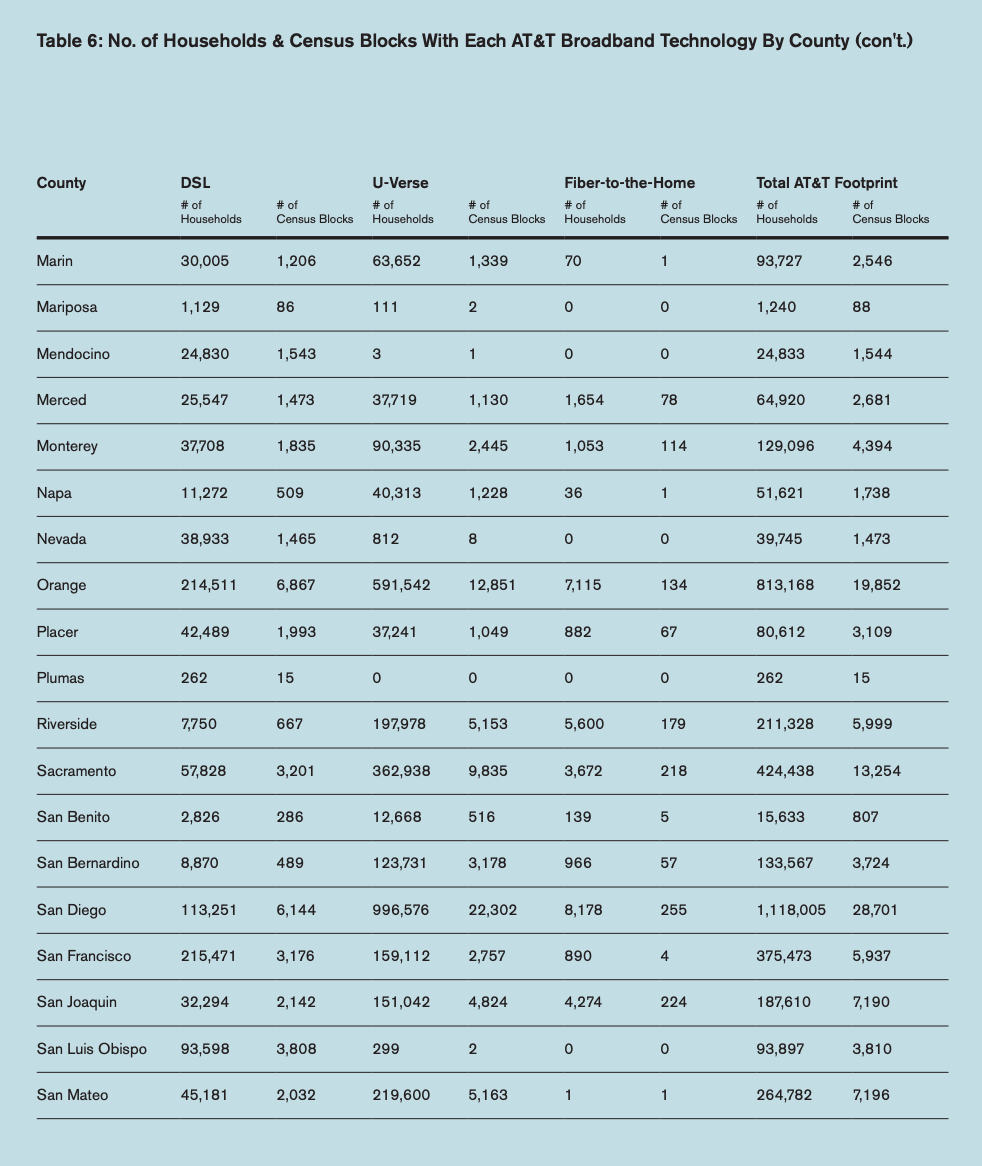


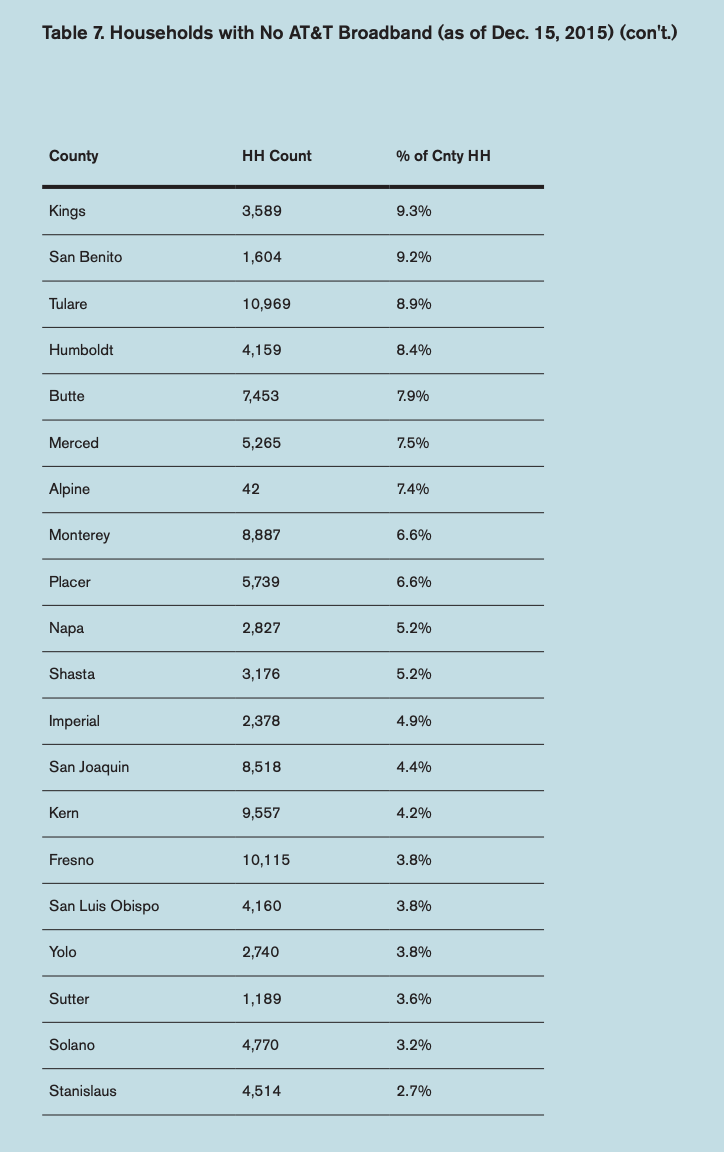
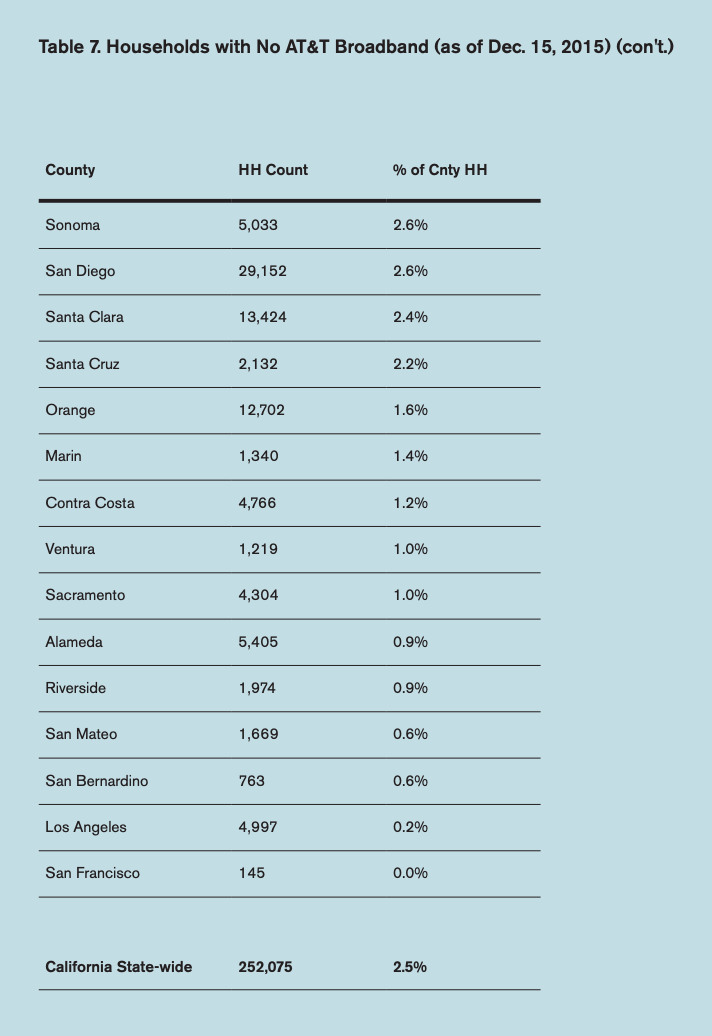

- 1AT&T Press Release, “AT&T Reports 4th Quarter and Full-Year Results,” Jan. 25, 2017 (available at http://about.att.com/story/att_fourth_quarter_earnings_2016.html).
- 2Council of Economic Advisors, “The Digital Divide and Economic Benefits of Broadband Access,” March 2016 (available at https://obamawhitehouse.archives.gov/sites/default/files/page/files/201…) Sources: California Emerging Technology Fund, “Internet Connectivity and the ‘Digital Divide’ in California Households: 2016,” July 2016; Testimony of Trevor R. Roycroft on Behalf of TURN, CPUC Competition Investigation I.15-11-007, filed 11/5/2015, public version 6/1/ 2016; CPUC Competition Report, Dec. 2016.
- 3This figure does not include the small number of households where AT&T is an incumbent local exchange carrier but offers no broadband services. In total, AT&T’s California wireline network spans 280,964 census blocks.
- 4FCC, Form 477 Data, June 30, 2016 (available at https://www.fcc.gov/general/broadband-deployment-data-fcc-form-477).
- 5U.S. Census Bureau, American Community Survey (ACS) 2011- 2015 (5-Year Estimates). Prepared by Social Explorer (available online at http://www.socialexplorer.com/explore/tables).
- 6FCC, 2016 Broadband Progress Report, Jan. 29, 2016 (available at https://apps.fcc.gov/edocs_public/attachmatch/FCC-16-6A1. pdf); California Public Utilities Commission, Decision Analyzing the California Telecommunications Market, Investigation 15-11-007, Dec. 8, 2016, pp 11,47-8 (available at http://docs.cpuc.ca.gov/PublishedDocs/Published/G000/M171/K031/17103195…).
- 7Author’s calculation from FCC ArcGIS File of AT&T ILEC territory and FCC Form 477 database, Dec. 15, 2015.
- 8FCC, AT&T/DirecTV Order, MB Docket No. 14-90, July 28, 2015 (rel) (available at https://www.fcc.gov/transaction/att-directv). AT&T Press Release, April 20, 2017.
- 9Over the next six years, AT&T has made a commitment to the FCC to use federal Connect America Fund subsidies to deploy broadband at a minimum of 10/1 Mbps to 141,000 underserved customer locations, but this will still leave more than half of AT&T’s wireline footprint without broadband access.
- 10A.B. 2987, Ch. 700, Stats. 2006.; Cal. Pub. Util. Code, §5800 – 5970 - Digital Infrastructure and Video Competition Act of 2006 (DIVCA).
- 11FCC, Form 477 Data, June 30, 2016 (available at https://www.fcc.gov/general/broadband-deployment-data-fcc-form-477)
- 12https://www.fcc.gov/general/technology-codes-used-fixed-broadband-deplo…
- 132010 was the most recent year in which the Census Bureau collected housing unit counts at the Census Block level. The statewide proportion of housing units by county has changed relatively little since 2010.
- 15The FCC’s March 2016 study areas Shapefile is available at https://github.com/FCC/SABdata/blob/master/study_areas_10mar16.zip


